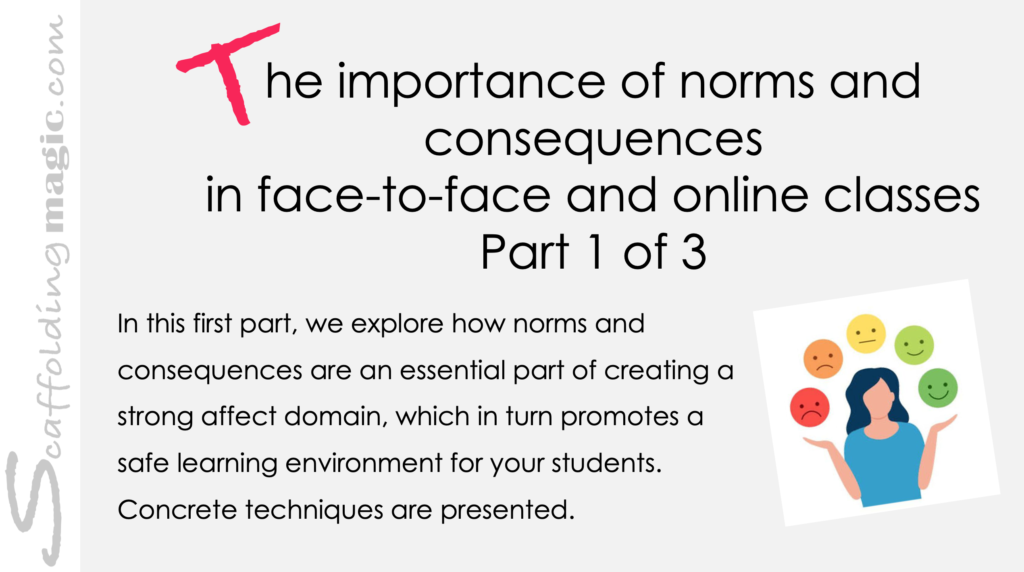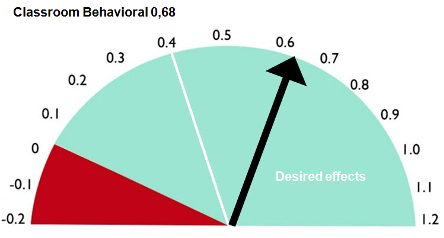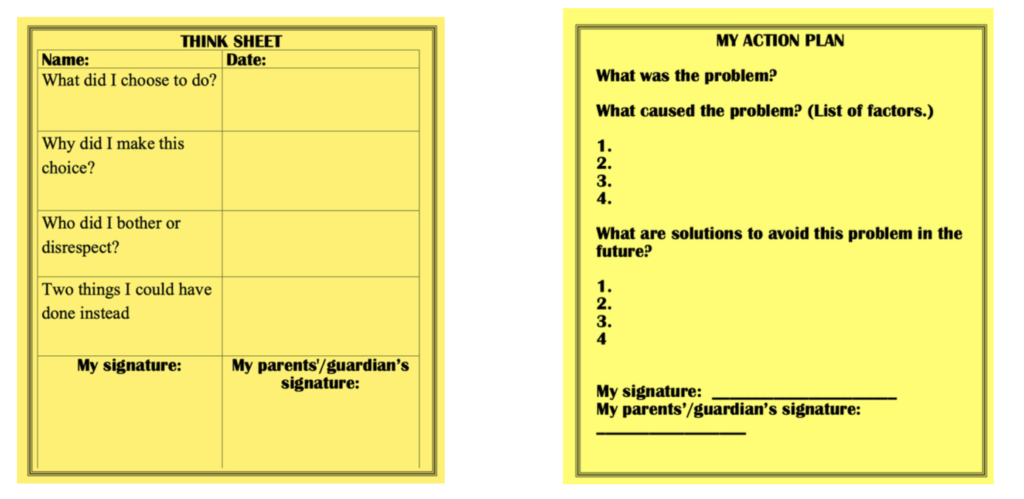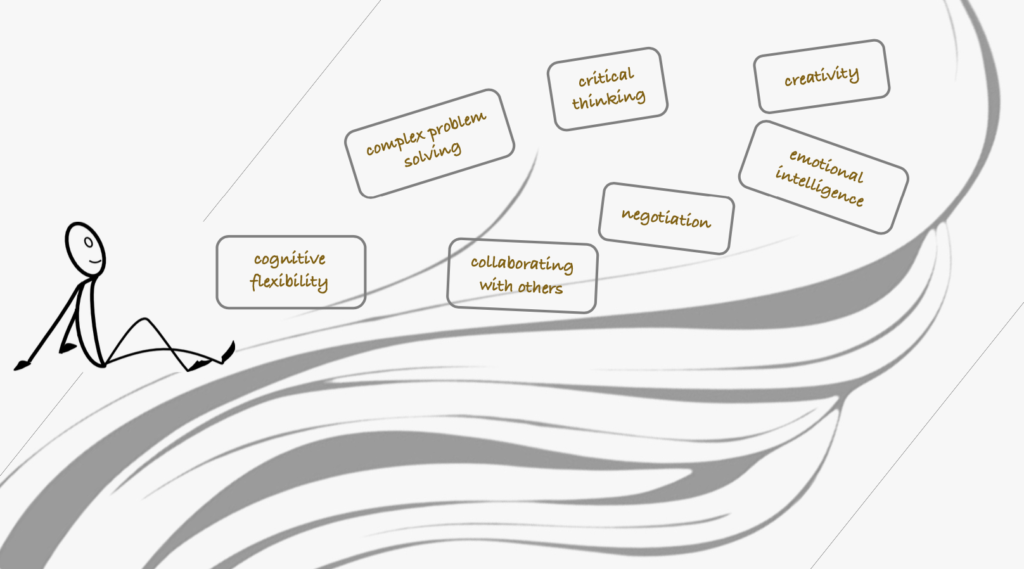
Download PDF of blog here.
Do routines promote strong learning environments?
Easy answer: YES! Yes they do!!!

How to begin…
- Get students involved in creating the norms and consequences
- Create a respectful learning environment by being respectful
- Use a sense of humour whenever possible
Jane Nelsen, Positive Discipline
Is most of your time carrying out lessons you’ve carefully planned for your students? Or do you find that most of your energy in class is spent trying to find ways to navigate your students’ inappropriate behaviour?
Let’s make this more visual. The following are two classroom scenarios. Which one is more like the one you teach in?
Trust me. The second scenario is not only possible, it’s occurring in hundreds of classrooms around the world.
1st scenario: The students enter the classroom and there is an immediate explosion of noise and movement. They shout back and forth to each other as they go to their desks, they pick up and slam down their chairs before sitting down, they throw papers at each other they’ve found on the floor, toss their backpacks on the tables loudly, and in general seem to delight in disrespectful behaviour.
2nd scenario: The students come in quietly, sit down at their seats, take out appropriate materials from their backpacks, work on the 5-minute warm-up activity you’ve left for them, consult each other* on any doubts they have without asking you, work on alternative material once they’ve finished while the rest are finishing, and then patiently wait for you to signal the beginning of the main lesson.
Trust me. The second scenario is not only possible, it’s occurring in hundreds of classrooms around the world.
It’s all in our expectations
The core difference between these two scenarios is not the population of students, but rather the teachers’ expectations. If you expect chaos –you get chaos. If you expect respect – respect for the learning environment, for the people in the learning environment, for the learning – respect is what you get.
Teachers who have never been trained in – or have learned in- respectful learning environments, don’t realise that they have the right to expect more. These teachers are not only anxious most of the day because of their students’ inappropriate behaviour and their seeming inability to have any effect on altering it, but also because they seem to only be able to complete half of the activities they planned on any given day.
Conclusion: Student behaviour and completion of lessons are not two distinct and separate factors: they are directly related.
For those of you who are familiar with the studies carried out by John Hattie and his team of researchers, you’ll appreciate the effect size of classroom behaviour on the influence of learning: 0,68 – an incredibly strong indicator.

Another way to see this:

So, how does this translate into our educational practices? Well, firstly we need to envision the learning environment you most want. Secondly, we need to establish and co-create the norms and consequences that will help our vision become a reality. Thirdly, we need to practice these norms and consequences with our students. (Just like everything else, these are routines that need to be learned.)
Envisioning your ideal learning environment. How clear can you be about the following:
- When my students enter the room, I would like them to….
- If they need to leave their seats, I would like them to…
- When I want their attention, all I need to do is…
- When they want to share, I would like them to…
- Before beginning an activity and they need materials, I would like them to…
- When I am speaking to another person and they have a question, I would like them to…
Norms and consequences that will promote this learning environment:

Building confidence between students and parents/guardians:

The Action Plan/Think Sheet are based on the dynamic that once you have established and co-created the norms and consequences, and the students and their parents/guardians have signed them, it is their choice to follow them and to accept the consequences if they choose not to. Thus, they need to take responsibility for their choices and reflect on other actions they could have taken.
As a further step in being proactive about a positive learning environment, you can send messages home at the end of each week to inform parents on the positive factors their children have shown in class. This helps build trust between you and the parents so that they will be more willing to work with you if problems occur.
* According to the most recent OECD report on the results of the Global Competences questionnaire, those students who have the support of their peers, score 50 points higher on PISA exams in reading than those who don’t. While exams per se are not our goals, the OECD conclusions are important as they have to do with the development of the child as a whole. Those students who can count on the collaboration of their peers in school, are more likely studying in learning environments with stronger affect domains, and so have an easier time assimilating new information. This, ultimately, has positive personal, academic and (future) professional consequences.
Resources
- CLIL Training Guide: Creating a CLIL Learning Community in Higher Education
- Daily routines
- The importance of routine in education
- 32 Classroom Routines every teacher needs
- Hattie, John Visible Learning
- Positive Discipline, Jane Nelsen
- scaffoldingmagic.com A website dedicated to providing dynamic and innovative activities that will help student to transition into new information.
- The Comprehensive Guide to Creating Phenomenon-Based Learning Projects The steps to create multi-cultural, interdisciplinary and collaborative projects.
- The First Day of School, Wong, Harry
- Teacher Training Videos Videos that teach how to use the most useful educational

Scaffoldingmagic.com is your entryway into DYNAMIC bilingual learning methodologies, such as Phenomenon-Based Learning, CLIL, EMI, and ESL. You’ll find ways to implement critical thinking tools (DOK) to promote higher level thinking, the growth mindset, instill an ethic of excellence, deep reflection on learning, and all through multi-cultural, interdisciplinary activities. We have the keys to turning competences into action and to creating collective efficacy in your school so you move ahead as a unified, enthusiastic team.
Pingback: The Importance of Routines, Norms and Consequences in Face-to-Face and Online Classes (Part 2 of 3) - Scaffolding Magic